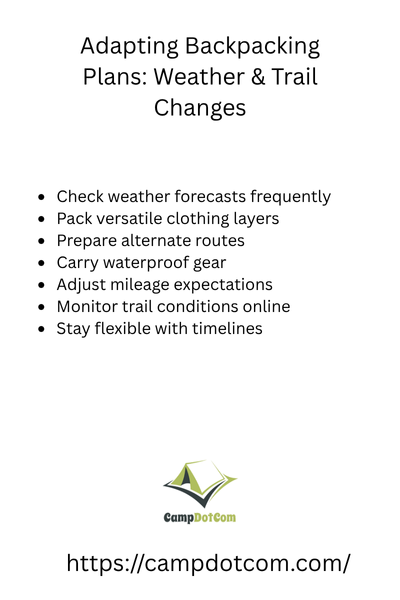Backpacking is an adventure, no doubt about it. But what do you do when the weather changes or the trail you were excited about suddenly becomes too difficult to follow?
That is where adjusting your backpacking plans for weather and trail changes really comes in handy. I have definitely been there, standing at the trailhead and checking the forecast over and over, hoping those rainclouds would just drift away. Spoiler alert, they did not.
Read More About Adapting Backpacking Plans

The Reality of Unpredictable Weather
You check the forecast, pack accordingly, and feel confident that you’re ready. But then, halfway up the mountain, the sky darkens, and you realize that the weather has its own agenda. It’s frustrating, but it’s also part of the adventure.
As an Amazon Associate, I earn from qualifying purchases. Some of the links in this article are affiliate links. This means that, at zero cost to you, I will earn an affiliate commission if you click through the link and finalize a purchase.
I once set out on a three-day trek, expecting mild weather, only to find myself trudging through unexpected snowfall on day two. Let’s just say I learned firsthand the importance of packing extra layers and waterproof gear!
The best way to handle these surprises? First, always check multiple weather sources before your trip. Apps like NOAA, Weather Underground, or even local ranger stations can provide a broader picture. But more importantly, prepare for a shift in conditions.
A lightweight poncho, extra socks, and an emergency bivy can make a world of difference if things take a turn.
More Things to Know About Adapting Backpacking Plans

When Trails Throw a Wrench in Your Plans
You planned your route, read the trip reports, and even watched a few YouTube videos of the trail. Everything felt ready. But then you arrive and find out that last week’s storm turned the trail into a muddy mess. Or a rockslide wiped out an important part of the path and now you are figuring out your next move.
One time, I set out on a long-distance hike only to find that a crucial bridge had been washed out. There was no way to cross safely, and turning back wasn’t an option I loved.
Thankfully, I had an alternate route mapped out. This saved me hours of stress and frustration.
Pro Tip: Always have a backup plan.
Even if the trail looks great on paper, reality can be different. Before you go, research alternative routes or nearby trails that could serve as a plan B. Carry a paper map (yes, old school but reliable) in case your phone dies.
And most importantly, stay mentally flexible. Adapting your backpacking plans to changing weather or trail conditions requires staying calm and making smart decisions in the moment.
Dealing with Mental & Physical Challenges
Changing plans on the fly isn’t just about logistics; it’s also about mindset. It’s easy to get frustrated when things don’t go according to plan, but shifting your perspective helps. Instead of seeing changes as roadblocks, think of them as part of the adventure.
Physically, adapting can mean pacing yourself differently, eating more snacks to keep energy levels up, or taking unexpected rest breaks when the terrain demands it.
Mentally, it’s about staying positive and focusing on what you can do rather than what you can’t.
Mastering the Art of Seamlessly Adapting Backpacking Plans on the Go
At the end of the day, backpacking is not just about following the original plan. It is about embracing whatever challenges the trail brings.
The best trips are those where you learn, grow, and return with a story worth sharing. So pack wisely, stay flexible, and remember that sometimes the greatest adventures come from unexpected detours.
